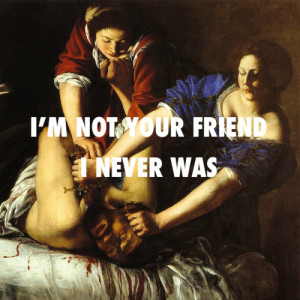Some of my most cherished memories are of watching my mother hang my paintings in the living room or chanting “GIRL POWER” with my father after I won a game of Ready 2 Rumble on Nintendo. Growing up during the ’90s was great. Here I am now in my early 20s, sitting through countless art history classes that feature entire lectures on the artistic innovations of men with a mere comment or two on their female counterparts. I have come to the realization that I will never be able to change the history books to give credit to these women masters, but I am going to bitch about it until someone else does.
Admittedly, I love Renaissance memes. (Thankfully, these sassy art history memes are now wearable). They get the images of highly important works on social media. They usually incorporate popular culture, and are completely vulgar. They also emphasize the utterly ridiculous nature of some of these paintings. For example, Titian’s Venus of Urbino.

This painting is what inspired me to write this blog and this meme is totally fitting for Titian’s intention. To informally analyze, we can see that this is pretty much 16th century Italian porn, more tastefully termed in art history classes as for the male gaze. Titian painted this solely for men by creating a perfect being with velvet skin, a body that is so curvaceous she seemingly has no bone structure, and the most cylindrical, perky breasts I have personally ever seen. Venus coyly touches herself and practically begs her male viewer to come closer with her eyes all while casually holding pretty flowers, just in case we didn’t catch that she is fruitful and DTF. For good measure, Titian adds her small dog at the end of the bed which always proves to be an icon for loyalty. As if to communicate to her soon to be lover, she is the most loyal of all the side hoes, even if he isn’t.
To be fair, Titian highly influenced the Italian Renaissance and future Western art through his technical application of paint and use of vivid, luminous colors. He is a figure that was and will be respected for his masterful works, and rightfully so. At the same time, Venus of Urbino was likely commissioned as the centerpiece of the patron’s living room, hanging blatantly for the men to stare at (think: boob tube, literally) and for women to uncomfortably avoid at all costs.

By contrast, we find this painting of pure female badassery. Artemisia Gentileschi was not a Renaissance artist but an Italian Baroque artist, who was trained by her father who was in Renaissance circles (let’s not over complicate this, Gentileschi is a “Renaissance” artist, okay?). Gentileschi was extremely progressive for her time due to the support from her father and her subject matter.
Gentileschi was raped and famously prosecuted her rapist, in a time when rape happened often and went without consequence. From her experience, she painted this: Judith Slaying Holofernes, a famous Biblical story in which Judith slays her rapist in his sleep. This story is a favorite of many artists like Caravaggio, Giorgione, and even Titian himself who all have their own renditions. So, what is special about Gentileschi’s Judith Slaying Holofernes? *screaming from the back row* SHE IS A WOMAN WHO WAS RAPED AND OVERCAME IT. Gentileschi empathized with Judith in a way that a male artist never could, which resulted in a super expressive and emotional interpretation.
The biographical story behind this work only makes the imagery that much more badass, blood-thirsty, and rebellious for the time. Judith has a skeleton and muscles, her sleeves are rolled up, and her facial expression says: Do not fuck with me. There is weight in the knife that she presses with her thick forearm into Holofernes’s neck, unforgivingly as blood actively spurts onto the sheets. Judith’s maid is by her side to hold his arms down with an equally as relentless expression. This painting serves as a great anti-rape advertisement, while amplifying the strength of female camaraderie.
As I write this, I’m questioning myself and why I was so inspired by Titian to even start this blog initially. Venus of Urbino and the male gaze are so fundamentally against how I believe women should be viewed or thought of in the context of art. I retract my previous statement and conclude that Gentileschi is the inspiration for my blog. Judith Slaying Holofernes embodies the new, female gaze through a ruthless interpretation of what it means to be a woman dealing with gender specific abuse and how empowering it is when it’s beaten.
